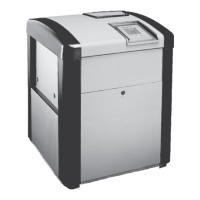Page 10
WARNING
Vent pipe diameter must be as required by the
National fuel Gas Code Z223.1 or the Canadian
Installation Codes for Gas Appliances CAN/
CSA-B149.1. Undersize pipe can result in
inadequate venting and oversize pipe can result
in vent condensation. In either case the result
can be release of combustion products to the
indoors. This can cause serious injury or death
by carbon monoxide poisoning or asphyxiation.
AVERTISSEMENT
Le diamètre des tuyaux de ventilation doit
répondre aux exigences du National Fuel Gas
Code Z223.1 ou du code canadien des
installations des appareils à gaz CAN/CSA
B149.1. Des tuyaux trop petits risquent
d’entraîner une ventilation inadéquate et des
tuyaux trop gros risquent de provoquer une
condensation dans les tuyaux. Dans un cas
comme dans l’autre, des produits de
combustion risquent de s’échapper dans le
bâtiment et causer des blessures graves ou
l’asphyxie par le monoxyde de carbone.
3.3 Vent Pipe Sizing and General
Installation
As part of their certification, the LX and LT Low
NOx heaters have been determined to be a Category 1
Fan-Assisted appliance. They are intended for stan-
dard vertical venting per tables provided in most local
codes for Category 1 Fan-Assisted appliances. If the
local code does not include such tables, refer to the
National Fuel Gas Code NFPA 54 / ANSI Z223.1 or
the Canadian Installation Codes for Gas Appliances
CAN/CSA-B149.1. Note that the tables for fan-
assisted appliances include both maximum and mini-
mum vent loading figures. The primary purpose of the
maximum ratings are to assure that the vent operates
with negative pressure throughout its length. The
minimum ratings are to assure that vent gases don’t
cool too much and thereby assure that condensation
doesn’t occur.
3.3.1 Outdoor Installations
For outdoor installations, exhaust venting consid-
erations will determine the placement of the heater
(See Section 2.3.4). If the heater cannot be placed so
as to meet the requirements stated in Section 2.3.4, a
vent collar may be added to the heater to move the
exhaust vent opening to a position that complies with
the requirements. In all cases, vent collars must be of
the same diameter as the exhaust outlet of the heater.
Approved vent collars may be obtained through your
Jandy distributor.
3.3.2 Indoor and Outdoor Shelter
Installations
All indoor installations and outdoor shelter
installations require the addition of a factory approved
vent collar. The vent collar must be installed without
modification.
All vent installations must be made in accor-
dance with all local, state or provincial codes and with:
1. Chapter 7, " Venting of Equipment" of the
national Fuel Gas Code, ANSI 223.1 latest
edition, or the applicable provisions of the local
building codes.
2 In Canada, CAN/CSA B149.1.
Avoid terminating heater vents near air condi-
tioning or air supply fans. The fans can pick up
exhaust flue products from the heater and return them
inside the building, creating a possible health hazard.
Do not locate the vent terminal where flue
products could strike against building materials and
cause degradation.
Vent opening should be well away from trees or
other obstructions that would prevent free air flow to
and from vent terminal. Do not terminate the vent
under decks, stairways, or car ports.
Be sure to support all venting so that connections
will not separate and so that the weight of the vent
pipe does not rest on the heater vent collar. All
connections should be made with rustproof sheet
metal screws. Do not weld or fasten the vent pipe to
the heater vent collar. The vent collar and heater top
must be easily removable for normal heater service
and inspection.
The vent collar outlet is to be connected to an
unobstructed vent pipe of the same diameter, terminat-
ing outside the building. The vent must terminate at
least two (2) feet (0.6 m) above the highest point of
the roof or other object that is within ten (10) feet (3.0
m) of the vent termination. The vent pipe must have a
listed vent cap which allows a full equivalent opening
for flue products (see Figure 7).
Type “B” double wall or equivalent vent pipe is
recommended. However, single wall metal vent pipe
may be used as specified in the latest edition of the
National Fuel Gas Code ANSI Z 223.1 or in Canada
CAN/CSA-B149.1.
IMPORTANT NOTE: Do not use sheet metal
screws at the snap lock joints of Type B gas
vents.
When venting multiple appliances through one
common duct, each appliance must have it's own vent
temperature limit switch. All vent limit switches must
be wired in series so as to prevent any appliance from
firing in the event of a blocked vent. Refer to ANSI
Z223.1 or, in Canada, to CAN/CSA B149.1 for more
information on multiple venting.
Table 4. Vent Pipe Sizing Table
LX/LT Vent Pipe Diameter
Low NOx
Model inch cm
250-L 7.0 17.8
400-L 9.0 22.9

